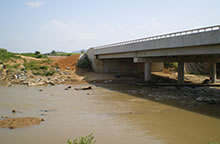
The market for sand in Abuja, Nigeria’s federal capital, is as undeveloped as the rapid development is in overdrive. Few African capital cities can boast of the same quantum of physical infrastructure development as is taking place in Abuja. Nor can any boast of equivalent potential of civil works getting started on such rapid basis. Abuja with an estimated population of around 1,000,000 claims substantial portion of Nigeria’s federal budget annually since it was inhabited as the federal capital in 1990.
Yet for all that infrastructure development very much of the sand supply for many private individual, corporate and government building projects is produced by artisanal sand miners using hoes and shovels. It may sound surprising but when DDH called at the Ministry of Mines and Steel Development (MMSD) which regulates sand mining, an official told the magazine that there is no record of a dredger working anywhere in the expansive federal capital. Rather sand from artisanal sand miners is still sold by using very local techniques: the local market measures with the number of the truck tyres: 6 tyres or 10 tyres or more, referring to the axial carriage of the trucks. These would turn out to be 6 tons or 10 tons respectively. But it cannot be ruled out that the big construction companies have sourced their sand needs from dedicated sites which they escavate and some say from the Usman dam but this is a topic that many of them do not want to discuss enthusiastically perhaps for reasons of compliance or lack thereof with official regulations on exploiting the mineral.
Still on our trail, we followed the sign of sand heaps by the side of the ever busy Abuja Airport road and traced the local sand miners to Gosa Kpai Kpai, a village that stretches from the airport road far into the hilly bushes of Gwari land. After nearly 20 kilometers of track road motoring, we came behind one of the huge rotund black rocks that dot the area, and met a spring trickling down from the rocks; narrow here, wide over there, but carrying in it, a forceful flow of sand and clayish water. At a clearing along this route, little mounds of sharp sand dotted the area as far as the eye can see. Some of the heaps were grayish smooth plaster sand. The majority was sharp sand heaps, grainy and dun in colour. All had been heaped for many days, possibly weeks. Down one large hole, we met one of the sand miners, bare-chested and muscular, with a wide, sharp hoe and a sizeable quantity of sand already scooped out of the path of the small stream. Named John, an indigene of Benue state, he informed us that this was his occupation; one that has kept him and his family fed for quite a few years now. Asked how he managed to bring up the sand heap to higher ground where trucks come to load them, he said he did it in sequences: after accumulating a sizeable quantity in the gully, he would thereafter use hoes or containers to bring it upland. Or as our guide chipped in, the family members, made up of wives and small children would troop down to the venue and contribute labour to achieve the feat. Welcome to sand supply business in Abuja!
Whereas Lagos, Warri and Port Harcourt sand dealers would deploy dredgers to produce large quantities of the needed crystals, here in Abuja, the market has to reckon with these lot whose production, despite the rudimentary nature, never fails.
On the business side of things, we gathered that truck drivers who manage to driver this deep into the bush to buy the sand make a near-100% gain on their prices. A 10-ton truck of sand bought at this stream-side for N14,200.00 goes for about N26,000.00 in town. And though the quantity seems small, our guide, Augustine, who has worked in Abuja for 16 years and lives in Gosa Kpai Kpai confirmed that major Abuja buildings like the Ecumenical Centre, Women Development Centre and very many other public edifices in Abuja Central Area district were built in the early 1990s with sand scooped from these humble locales. At the time Augustine worked with a civil engineering company which charged him with supervising the supply of aggregates and, in that capacity, he worked closely with other workers handling sand supply. General Ibrahim Babangida, smarting from the scare of the Gideon Orkar coup had just moved the seat of federal power to Abuja and the territory had sparse population and poorly developed commercial life.
When DDH asked John, the sand miner, whether any government agency had interacted with him on the business he was doing, he said no but expressed desire that government might offer him aid in the form of a truck so that he could do deliveries for his customers. He said he was not alone in the area; there were other artisanal miners all along the stretch of the small stream down to the big river down the slopes. Do they have any formalized union? No, he said, but everyone knew everyone else.
They have a chairman and that is the end of officialdom in this simple society of artisans based in the bush. As we finished our conversation and turned to leave, there were noises from nearby gullies; possibly John’s colleagues…raising their heads to ascertain the business of these obvious strangers to their reclusive enclave.
Anyway we strode off to visit other venues on the trail of sand: Apo River, Kuje waterside and other springs …..
But it’s really a wonder that not a single dredger can be found in the federal capital territory. A geologist at the federal ministry of mines and steel development ascribed this to “the general rocky nature of the terrain which has not sustained a wide river with huge quantities of sharp sand. And because of this topography, what is available cannot even be called sharp sand in the real sense of the word, according to the geologist. But the industry, small as it is, continues to satisfy the sand needs of the territory which are mainly for road construction and housing developments.
At Apo River, in another outskirt of Abuja, a larger number of the artisanal sand miners were active, scooping sand from one rivulet. One miner DDH interviewed, by name Lawal, hailed from Katsina state and had been at that spot for six years. Lawal who is employed as a security man in a nearby big house, maintains the sand mining job in the day time and sometimes at night. He said he produces between 2 and 3 trips of sand daily and the trucks regularly come to buy from him but the pricing structure is what he would like to change. In the Abuja sand market, as said earlier, sand is sold by number of truck tyres. Lawal said a 6-tyre truck load which he sells to truck drivers at N3,000.00 is resold in town for N11,000.00 while a 10- tyre truck load bought off him at N6,000.00 could go for as high as N23,000.00 depending on the bargaining power of truck driver.
He felt that the business did not favour him and his fellows who do the really hard work. Still in comparison to his security job Lawal felt more enamored to the petty sand mining venture. As he told us in broken English, “this work better pass government work, for my mind. Because, everyday if I dey work, if sand dey, I de get 2or 3 trips, N6,000.00 to N9,000.00. But if sand no dey, maybe you go do 3 days before you get one trip of N3,000. So, even the security work wey I de do, the money no go reach anything.”
When asked about any hazards of the job, he said there were very dangerous snakes in the area, the big ones that kill and swallow small cows. Hear him “ big big snakes dey this area. If na de one wey I dey chop, I go kill am. I don kill snake wey pass my body (size) for Katsina”. Lawal told quite intriguing stories, about the types of big snakes he dared not confront, some as long as 60 feet and very big. He said when these big snakes which live inside a nearby rock move through the area, mainly at night, they would press down large swathes of bush and everybody, including strong hunters in the area, would normally run for dear life. Lawal identifies the big snakes’ abode as the nearby big rocks having tall bushes and grasses and abundant virgin land. No human feet have trod in these rocky places which surround the river where Lawal and his friends are operating. Stories abound about monkeys and chimpanzees up these scary heights. But the business of sand mining dwarfs these realities because of the insatiable need for the building component which includes aggregates. Where sand may be rare, however, aggregates are plenteous.
Abuja as a rocky terrain furnishes abundant ground for the production of aggregates. Rock blasting is common here by all categories of operators. At the MMSD, another official who spoke to DDH off the record said there were between 50 and 70 registered operators of quarries in the federal capital territory. He concurred that there were no dredgers for sand in the FCT mainly because of the lack of big rivers. But he maintained, at the same time, that no scarcity of sand has ever been observed in the area despite the fact that only artisanal and small scale sand miners were the only known producers. He did not rule out the possibility of the big construction companies going far away to places like Abaji, Gwagwalada or similar distant locations to produce sand. Some of the local rivers and water bodies being figured as sources of sand of diverse quantities include Guisape Dam, Ushafa Dam, Usman Dam, River Gurrara and Kuje.
When we queried the official what roles they are playing in regulation of sand mining in the FCT, he admitted that they did not have any registered sand miners or dealers; only quarries. Both the geologist and the MMSD official said at the moment they were geared to provide only “extension services” to operators of mines in the area. These, according to them, include advice on health and safety methods and urging the operators to form cooperatives which can approach government for various assistance programmes. They mentioned a World Bank facilitation programme that seeks to equip the artisanal quarries with modern hammers that can aid their increased daily productivity.
At the end of the investigative tour of the Abuja sand and gravel production market, it is noteworthy to report the opinions of some civil engineers who have worked in the city for many years and who have made significant opinions on the subject. One of them, names withheld, maintained that the big construction companies relied an four main production point, for some of their sand needs, namely: Suleja, Nyanyan, Lower Usman Dam and the river bed flowing across the Airport-Gwagwalada highway. The pin point veracity of this claim is yet to be ascertained.
